| Columns Retired Columns & Blogs |
Rega Apollo CD player Measurements
Sidebar 3: Measurements
The Rega Apollo had a maximum output level of 2.175V at 1kHz, 0.73dB above the CD standard of 2V RMS. Its output preserved absolute polarity (ie, was noninverting). The Apollo's output impedance was a little higher than usual, at 596 ohms over most of the audioband and rising slightly to 653 ohms at 20Hz, but this should have no subjective consequences, even with amplifiers having a low input impedance. The Rega's error correction, assessed using the Pierre Verany Test CD, was simply superb, the player coping with gaps in the data spiral up to 2.4mm long without either audible glitches or the error flag in its digital output being set. However, it did stumble when playing back CD-Rs, which have lower reflectivity than CDs. Some of my older test discs—all of my CD-player test tones are burned onto CD-Rs—played back with frequent dropouts and glitches.
The Apollo's frequency response rolled off slightly at the very top of the audioband, reaching an inconsequential –0.5dB at 20kHz (fig.1, top pair of traces), the rolloff increasing very slightly during playback of pre-emphasized data (fig.1, lower traces). Channel separation (not shown) was superb in the midband, with any crosstalk buried beneath the noise floor. However, the usual capacitive coupling degraded the separation to a still excellent 100dB at 20kHz. It also decreased to 90dB at 20Hz, suggesting a power-supply impedance slightly higher than usual.
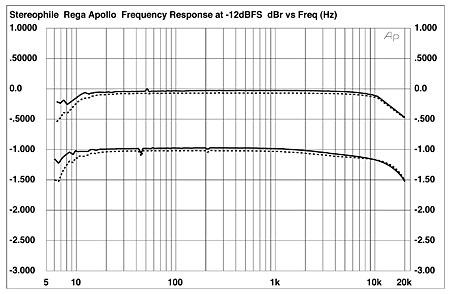
Fig.1 Rega Apollo, frequency response at –12dBFS into 100k ohms, with de-emphasis (bottom below 1kHz) and without (right channel dashed, 0.5dB/vertical div.).
Fig.2 shows the spectrum of the Apollo's output while it decoded dithered data representing a 1kHz sinewave at –90dBFS. The trace peaks exactly at this level and is free from harmonic spuriae, though there is a little more low-frequency noise than I usually find. Repeating the test over a wider bandwidth and with data representing a –1LSB DC offset gave a spectrum with a lower level of noise (fig.3), and without the expected ultrasonic rise due to the DAC's noiseshaping. It looks as if the Rega's DAC mutes its output when fed this signal, to give an optimistically high signal/noise ratio.
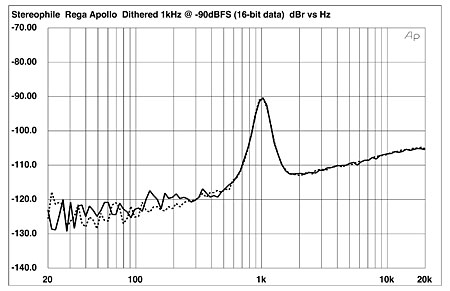
Fig.2 Rega Apollo, 1/3-octave spectrum of dithered 1kHz tone at –90dBFS, with noise and spuriae (16-bit CD data, right channel dashed).
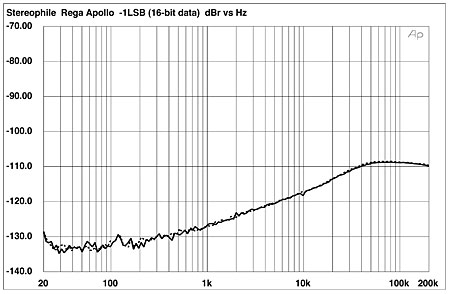
Fig.3 Rega Apollo, 1/3-octave spectrum of –1LSB DC offset, with noise and spuriae (16-bit CD data, right channel dashed).
The Rega's linearity error is shown in fig.4. The output becomes increasingly dominated by noise below –100dBFS, both recorded dither and analog playback noise, with negligible error. This good DAC performance is confirmed by the waveform of an undithered 1kHz tone at exactly –90.31dBFS (fig.5), which is both symmetrical and clearly shows the three DC voltage levels that describe this signal.
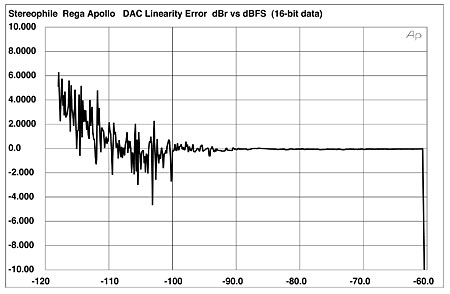
Fig.4 Rega Apollo, left-channel departure from linearity, 16-bit CD data (2dB/vertical div.).
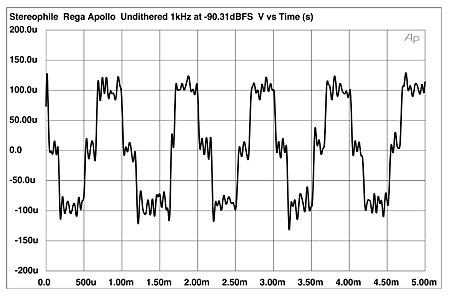
Fig.5 Rega Apollo, waveform of undithered 1kHz sinewave at –90.31dBFS, 16-bit CD data.
Distortion levels with full-scale signals were very low, at 0.009%, though the spectrum of that distortion revealed some differences between the channels (fig.6). The subjectively innocuous second harmonic was the highest in both channels, followed by the third and then the fourth harmonics. However, the right channel had a higher level of third harmonic, and featured some fifth and seventh harmonics. Admittedly, these are all at very low levels, but I prefer not to see such behavior at all. Intermodulation distortion was very low (fig.7).
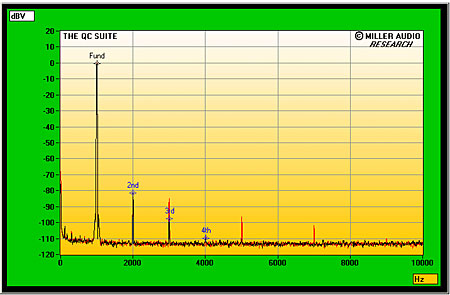
Fig.6 Rega Apollo, spectrum of 1kHz sinewave at 0dBFS into 4k ohms, DC–10kHz (linear frequency scale).
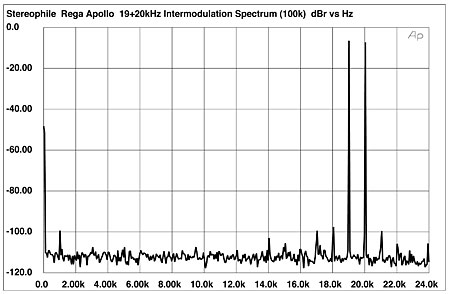
Fig.7 Rega Apollo, HF intermodulation spectrum, 19+20kHz at 0dBFS peak into 100k ohms, DC–24kHz (linear frequency scale).
Finally, I tested the Apollo's rejection of word-clock jitter using the Miller Analyzer and a test CD-R carrying the diagnostic signal: a high-level tone at exactly one quarter the sample rate, over which has been laid the LSB toggling on and off at a low frequency, again an exact integer fraction of the sample rate. The measured jitter level was a low 293 picoseconds peak–peak. A narrowband spectral analysis of the Apollo's analog output is shown in fig.8: the data-related sidebands (red numeric markers) are all very low in level, with most of the jitter deriving from a pair of sidebands of unknown origin at ±1350Hz (purple "8" markers). Low-frequency sidebands can also be seen at ±51Hz (purple "1") and ±120Hz (blue "2"), the latter obviously power-supply–related.
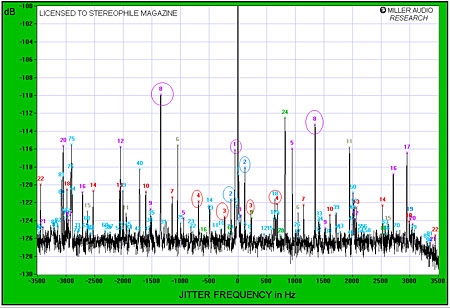
Fig.8 Rega Apollo, high-resolution jitter spectrum of analog output signal (11.025kHz at –6dBFS sampled at 44.1kHz with LSB toggled at 229Hz, 16-bit CD data). Center frequency of trace, 11.025kHz; frequency range, ±3.5kHz.
Overall, this is excellent measured performance, though I was a bit bothered by the difficulties the Apollo had tracking CD-Rs.—John Atkinson
- Log in or register to post comments



































